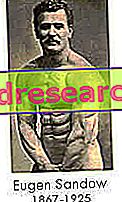By Dr. Luca Franzon
"... You would sit among the spectators and observe the courage and physical beauty of men, their marvelous form, their impressive ability, their invincible strength and their indefatigable will to win ..."
These are words spoken by Solon to Anacarsi in ancient Greece, where the concept of strength was already known and admired.

Over the years, many scholars including: Verkhoshanky, Hatfield, Zarciorskij, Bosco, Vittori, Cometti have tried to define the concept of muscular strength, and have devised training protocols to increase strength in athletes.
These are the most significant definitions given to the concept of force by the authors mentioned above:
"Muscle strength can be defined as the ability that the intimate components of muscular matter have to contract, in practice to shorten". (Vittori)
"Strength is the ability of skeletal muscle to produce tension in various manifestations". (Verchosanskij)
"The strength of man can be defined as his ability to overcome an external resistance or to oppose it with a muscular effort". (Zaciorrskij)
We must then give Harre the division of force into:
MAXIMUM FORCE: it is the highest force that the neuro-muscular system is able to express with a voluntary contraction.
FAST FORCE: it is the ability of the neuro-muscular system to overcome resistance with a high rate of contraction.
RESISTANT FORCE: it is the ability of the organism to oppose fatigue during strength performance over time.
The various force expressions previously mentioned: maximum strength, explosive force, resistance to explosive force and muscular resistance can be classified according to biological principles. These expressions can be classified taking into consideration both the neuromuscular aspects, which serve to modulate the tension, and the metabolic aspects that determine their duration. Therefore the maximum force and the explosive force are characterized by neurogenic factors, while the resistance to the explosive force and the muscular resistance are characterized by metabolic factors.
Strength, speed, endurance are the sine qua non conditions for achieving successful performance. The dominant capacity is the conditional capacity to which a motor performance requires a higher contribution. Most motor activities require an optimal performance of at least two qualities of the three listed. The development of one of the three conditional capacities must take place methodically, since it directly or indirectly affects the others.
Strength is a fundamental skill that however must be trained together with the others so as not to become counterproductive. Strength is in an athlete what the foundations represent for a home. Strength is the basis from which to start. A cyclist cannot think of winning a final sprint if he has not trained strength, a volleyball player cannot think of jumping higher if he has not trained strength and a bodybuilder cannot think of developing further hypertrophy if he has not trained strength.
Of the three types of force classified by Harre the maximum strength is the first to be trained. Once this quality has improved then it can be transformed into other types of strength with adequate training. The maximal force can therefore become, explosive, resistant or can become hypertrophy.
The improvement of the maximum force occurs first with adaptations and modifications at the level of the nervous system then with morphological transformations that will lead to hypertrophy.
Very probably the adaptations at the neural level act both at central and peripheral level, this determines as a final result a maximal activation of all muscle fibers (Millner-Brown et coll. 1975). These modifications will give the possibility to immediately recruit a very high number of muscle fibers, triggering all those processes that determine the explosive force.
Changes at the level of the nervous system will ensure that both intramuscular and intermuscular coordination improve, resulting in energy savings and an increase in the speed of execution of a movement.
A fundamental concept, because it will be the means by which we will develop strength, is the concept of load . Small loads can get high voltages through the speed of movement but it is not optimal to use low loads and high repetitions because in this training situation the alternation of the recruitment of the motor units comes into play which does not lead to the improvement of strength. A high load will also give greater supercompensation. If you do not produce high muscle tension through optimal loads, you do not produce strength gains.
Training methods to increase maximum strength are varied and include:
Repeated stress method
Series method
Pyramidal method
Dynamic method
Maximum effort method
Static or isometric stress method
Contrast methods
The methods listed above are the result of the studies of the authors discussed at the beginning of the article and are methods that combine well with performance sports. With regards to strength training for the body builder or the advanced fitness practitioner, the aim is to increase the ability to recruit motor units, so that they can then make the most of mesocycles with hypertrophic purposes.
In principle these are the characteristics to build the force table :
load between 75% -100% of MRI.
repetitions from 1 to 8/10.
6-10 series per exercise.
1-2 exercises per muscle sector.
recovery time between series from 3 to 5 minutes.
duration of the mesocycle from 6 to 10 weeks.
In the mesocycle of strength it is not uncommon to experience injuries caused by the use of too high loads. The load we said that is the means to become stronger but unlike other sports where raising a high load means winning a race, in body building we said that strength has other goals that are not purely performance.
At this point I just have to close the article with an inevitable phrase when it comes to strength ..... THAT THE FORCE IS WITH YOU !!!!!!
SHEET A
*BENCH
CROSS 3X6 / 8
* CURL BALANCE
SHEET B
* SQUAT OR PRESS
LEG CURL 3 / 4X6 / 8
* CALF
SHEET C
* SLOW FORWARD
PULL AT THE CHILD IMP. WIDE 3X6 / 8
* PUSHED ON PIANA PIANA NARROW HANDLE
CARD D
* PULLEY
TRACTIONS TO BAR 3 / 4XMAX
EXERCISES BASE TDR (recovery time) - 2/3 '-
COMPLEMENTARY EXERCISES TDR - 1.30 / 2 '-
ALL 1 6X10
ALL 3 7X10
ALL 5 8X10
ALL 7 8X8
ALL 9 8X6
ALL 11 8X4
| CARD 1 | ||
PANCA PIANA CROSS CABLES HIGH SHOULDER PRESS FRONTAL LIFTS CURL WITH HANDLEBARS SCOTT BENCH WITH HANDLEBARS | 15-12-10-8-6 3/4 X 12/15 15-12-10-8-6 3/4 X 12/15 15-12-10-8-6 3/4 X 12/15 | |
| CARD 2 | ||
CALF ON FOOT CALF SEATED LEG CURL SDRAIATO HPX WITH OVERLOAD SQUAT SINK WITH HANDLEBARS | 15-12-10-8-6 3/4 X 20/25 15-12-10-8-6 3/4 X 12/15 15-12-10-8-6 3/4 X 12/15 | |
| CARD 3 | ||
PULLEY LAT MACHINE WITH TRIANGLE PUSHED ON BENCH IMP. NARROW TRICIPIT BUST 90 ° RAISE 90 ° | 15-12-10-8-6 3/4 x 12/15 15-12-10-8-6 3/4 X 12/15 3/4 X 12/15 | |
| EXERCISES BASE TDR 1.30 " EXERCISES COMP. TDR 1.00 ' |
SEPT. N. | LUN | Tues. | MER | GIO | FRI | SAB | DOM |
1 | TO | B | C | D | |||
2 | 1 | 2 | 3 | ||||
3 | TO | B | C | D | |||
4 | 1 | 2 | 3 | ||||
5 | TO | B | C | D | |||
6 | 1 | 2 | 3 | ||||
7 | TO | B | C | D | |||
8 | 1 | 2 | 3 | ||||
9 | TO | B | C | D | |||
10 | 1 | 2 | 3 | ||||
11 | TO | B | C | D | |||
12 | 1 | 2 | 3 |
BIBLIOGRAPHY



